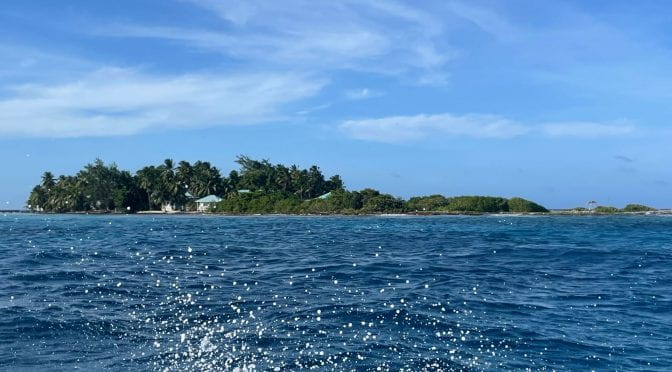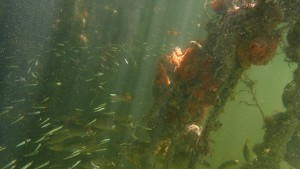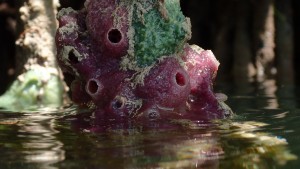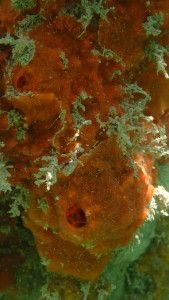We have finally arrived at glover’s! Most of the day was spent traveling, which was a much needed rest after our week of activities. We took a 3 hour, windy, sunny, beautiful boat ride. It was so cool to pass by islands and see the start of the laguna and the atoll. The barrier reef made the waters really choppy at some times, which made the ride extra fun. I can’t wait to see those corals up close in person tomorrow!!! When we got here, we hung out on the dock for a long time because it was so gorgeous and peaceful. The weather is a hige upgrade from Chiquibul, because there is a lovely salty breeze, and even fans in the rooms! The main issue is the SAND FLIES EVERYWHERE. I already have so many bites. Now i know to avoid the sand as much as i can and where a jacket and bug spray. After just being here for a few hours, we have already seen so much life including pelicans, a nurse shark, bone fish, and more ginormous crabs than I have ever seen in my life. Tomorrow morning is our first snorkel! I’m really looking forward to getting the hang of snorkeling in the reef.
Tag Archives: Glover’s Atoll
DAY 1- ARRIVING AT GLOVER’S REEF
After a restless night of anticipation and excitement, I woke up 5 am to have plenty of time to meet up with the rest of our tropical field biology class to make it to our flight at 6:15 am. It was a good thing that we arrived early because their was an unforeseen mix up with the requirement of notarized permission slips for our youngest travelers, and someone forgot to print out their boarding pass (you guessed it…it was yours truly). I am incredibly glad to have such supportive and kind classmates that waited for me. Thankfully, we all arrived in Belize in one piece and took a trip to the local grocery store for some snacks. While noticing the dense, green vegetation and beautiful pastel house colors of Belize City, I had a fascinating conversation with Dr. Correa’s mature and kind 10 year old son. He told me that while snorkeling it is extremely important not to touch marine life. I said that one time while snorkeling he touched a fireworm. He described the fireworm perfectly. It was small and wiggly with a light orange/pink coloring with small white bristles on the sides. After touching the fireworm he said he had burning feeling that felt like glass in his hand. This is probably this annelid’s self defense mechanism so moral of the story- don’t touch marine life but admire their beauty from a distance. I was presently surprised tolearn more about the taxa I researched on the first day!
While buying some plantain chips recommended by Dr. Solomon, I received my first Belizean dollars. One of our leaders, Claudius told me that the woman on the dollar was Queen Elizabeth as the Belize used to be called “British Honduras.” This dollar also pictured the mahogany tree (state tree), tapir (state animal), toucan (state bird), and the black orchid (state flower). Learning the history of Belize was very fulfilling!
The boat ride to Glover’s Reef was longer, hotter, and more bumpy than expected but there was a part of me that wished that it wouldn’t end because it filled me with a deep sense of nostalgia. There were so many aspects about the boat ride that reminded me about the Marshall Islands, and I really miss it. The salty sea spray, waves crashing upon the boat, and even the appearance of the atolls were similar. The Caribbean atolls are typically much more ancient that Pacific atolls because there is not current major tectonic plate movement. I learned from Dr. Correa and Claudius that Glover’s Reef is the second longest reef in the entire world which spans from Mexico, to Honduras, and to Belize (where most of it is located). I feel so incredibly amazed that we have the chance to snorkel this reef tomorrow!
P.S. HAPPY WORLD OCEANS DAY! 🙂
~ Maegan Aljure
Getting to Glovers!!! (Day 1)
Hi all, it’s Faith here with Day 1 updates from our Belize trip!!!
Today, we spent such long time just trying to get here, so I’m a little worried about the intensity for the next few days, but I didn’t sign up for this thinking it would be easy! Here is what happened:
The whole group made it on time and to the airport by 8:00, but not even 10 minutes in, we ran into our first problem– the professors hadn’t filled out the paperwork to bring their kids!
So, while we were reorganizing the class gear to be under 50lbs, the professors were rushing to get their kids on board. Don’t worry though, we all made it on the plane, and had time to grab panda express for breakfast.
After some seat and boarding pass complications, we made it to the Belize city airport, and went through an hours worth of customs! Then we temporarily lost Professor Solomon (which was kind of my fault because I didn’t follow him outside, but no one has to know).
After a brief stop at the supermarket to grab snacks, we headed to the boat for a 4 hour boat ride. On the way there, Dr. Correa’s son was telling Maegan and I that he wanted to see rollercoaster-like waves once we passed the barrier reef. We got kinda confused, but he was right, and we saw huge waves!
Not much happened after the boat trip. We just got our rooms, ate some yummy dinner, went over the station’s basics, and admired lots and lots and lots of hermit crabs. Fun fact: on the way back from the shower a giant ghost crab ran into me.
Sadly there were no echinoderms today because we were on land, but I’ll let you know what we find tomorrow.
I saw one reptile, a common house gecko Hemidactylus frenatus on the shower wall. He was cute and although patternless.
Quote of the day: “Don’t just write ‘Oh, I saw that dang tree again!’ I can confirm *laughs* there are gonna be trees in the rainforest, thank goodness” -Dr. Solomon
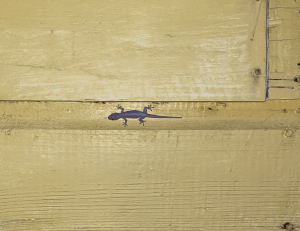
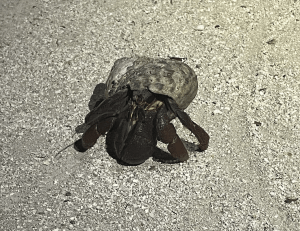
Final Snorkel and Travel to Houston
Waking and knowing this was our last day of Tropical Field Biology instilled in me a bittersweet mood that would last all day. Interactions with professors and classmates were charged with notions of remembering. Attitudes like this can cloud an experience, so I tried my best to keep the mentality of “screw it let’s do it” that made this class so special.
We made a few last minute stops on our boat ride to Belize City. The first was to see the Smithsonian research post at Carrie Bow Caye. Here we were greeted by a mild mannered couple from Idaho who were acting as the caretakers of the station—a position they have returned to for four weeks each year. Pretty sweet gig. It was enlightening to tour around the small facility and envision what it would be like to conduct formal research in such isolation. It seemed like the perfect place to have total peace of mind and clarity of thought—an ideal atmosphere for the task of those who enter it.
The next stop was our last snorkel. This time in a densely wooded mangrove. As our boat approached the dock we became aware of the fertile smell emanating from this forest isle. Self perpetuating and incredibly productive, the mangroves of Belize act as a nursery to juvenile marine predators and prey alike.
This location was also especially interesting as a study site for my marine taxonomic group (sponges) because of the unique symbiosis poriferans have with the mangrove trees. They grow on the roots of the red mangrove tree and nutrients fixed from the surrounding waters that aid the growth of the tree.
The substrate of the mangrove roots provides a home for these sponges where they are safe to filter feed out of harms way. One of the sponges I saw here was the toxic Tedania ignis or Fire Sponge, as it is commonly known.
When you touch this sponge it touches you back, with a painful sting and a lingering rash.
This concluded the formal class experience, so to speak. We dined again at Calypso, a restaurant by the docks known for its slow service and delicious lime juice. Then we bussed the rest of the way to Belize City airport where we finally disembarked for Houston. Arrival in Houston and goodbyes followed. Now, writing this blog in the relative security and sterility of Rice University, the entire experience seems like a fading memory. Where is wealth of life that just hours ago surrounded and fascinated me?
Let’s just say I’m glad we all took so many photos. I don’t want to forget what just happened.
Wrapping up
Our last day at Glovers has been bittersweet. We wrapped things up by collecting specimens from the backreef and bringing them into the wet lab for sorting and identification. While I did see several split crown feather dusters they are not the kind of thing you can remove from the reef without killing the organism because of how they attach to the substrate. However, we collected several fish, blue crabs, tiny brown crabs, all kinds of green, brown, and red algae, mantis shrimp, jellies, clam shells, and a huge hermit crab.
Yesterday we collected data on specific coral colonies for a long term study. We measured live coral coverage, and today we looked at the data for the same corals taken last year to compare the results. We found that coverage seemed to have decreased at the sites, but it was hard to tell because of discrepancies in data collection. Lastly, we dissected lionfish that were caught throughout the week to look at size, sex and stomach contents to get an idea of what the population of this invasive species looks like in Glovers atoll.
I wish I had more time on the reef and in this course. Middle caye and the surrounding reefs are beautiful and I feel like I could stay here for a long time. I may be salty, all my laundry is filthy, and I definitely have a whole new threshold for dirty, but I’m still happy as a clam.
Sophia Streeter
5/30
Last full day
The last night of our trip came too quickly. This atoll we came to so many days ago still doesn’t feel like a real place to me. It’s like this has all been a never-ending movie. Despite that it will end tomorrow. We will pull into Rice tomorrow night and it will all be over.
Enough sentimentality though, let me recap the day. Morning was spent returning to a very special spot on the back reef to collect specimens for a final display of marine organisms. Algae, crustaceans, and even box jellies were all represented in this summary of our taxa. I found a sponge in this area of the reef but was unable to identify it. It was soft, green, and encrusting but it didn’t look like any of the sponges from the Glover’s ID guide.
After the last of the lecture topics, we analyzed the data collected yesterday on percent cover of live coral on colonies measured last year in order to basically start a longitudinal study. This would be a great opportunity to look at coral colonies over the years and how they change in shape and size.
The afternoon was spent dissecting lionfish we had caught this week at the various sites we visited on the reef. Sam and I had the littlest guy, which was too immature to determine its sex. But we did open up its stomach and reveal a gross fish mush. I don’t know. It was gross but in the end we got to use the filets to make ceviche so it was all worth it.
I’m trying to make the most of these last dozen or so hours here at Glover’s. I think exploring the island a little more is in order. Sleep will certainly not come easily tonight despite the work we’ve been putting in all day. I can’t let this experience slip by too quickly.
Beach cleanup and backreef
Beach cleanup was on this morning’s agenda, and, being Rice students, we also weighed and separated all the types of marine debris and analyzed the results. The amount of garbage on the shore was astounding; we filled 6 garbage bags in an hour, and this is on a beach that is in a protected area and cleaned weekly. We only made a dent in the amount of debris accumulated on the island’s shores. I guess the take-home message to anyone reading this would be to limit your use of plastics as much as possible, stop using styrofoam, and be very careful about where your waste ends up (even properly disposed of trash often ends up in the ocean).
We went out to the backreef again today to document some coral colonies. I saw some more split crown feather dusters, spaghetti worms, a christmas tree worm, a teeny tiny star horseshoe worm, and finally a free-moving worm (as opposed to the others, which are tube dwelling). The fireworm is a marine worm that belongs to the same class as the feather dusters and fan worms but looks more like a caterpillar. It is red with white tufts, and, true to its name, will sting you if you touch it.
Sophia Streeter
5/29
It Ends With a Night Snorkel
Our morning activity today was sobering. Our task was to design an experiment that would answer some question about marine debris. We chose to analyze the composition of the trash washed ashore on the windward side of this island, Middle Caye. Simply, we would collect refuse and sort it to find out the percent by weight of each kind of material (plastic, foam, etc). What lay before us was hundreds and thousands of scraps littering the pristine rocky beach. We only searched for one hour, but we accumulate, as a group of fourteen, more than ninety pounds of debris. The majority of the volume was styrofoam and hard plastic, with total plastic weighing more than double the total styrofoam (naturally). We learned from the staff here that this type of cleanup is a weekly occurrence, which made out efforts seem like casually shoveling your driveway in the middle of a blizzard. Sobering.
Among the styrofoam debris, some of my classmates collected some spongy objects that actually tuned out to be the siliceous skeletons of actual sea sponges! PSA: Dead sponges do not float, or at least the two or three we collected alongside the garbage.
The afternoon passed quickly with another quadrat survey of coral cover. After dinner we heard a bad-ass lecture from the fisheries managers who regaled us with the ins and outs of their job including threats from fisherman, bribes, and what seemed like the closest things to espionage in the conservation business.
After that we did a night snorkel which represented the first time I’d ever been in the ocean after sundown. I has always heard this was primetime for shark activity, although we didn’t see any near the patch reef we visited. On the list of things we spotted at night were: a cute little slipper lobster, a yellow stingray, many sea cucumbers, a nassau grouper, and corals with their tentacles extended! I expected to be terrified by the abyssal darkness, but instead I was intrigued by what I was seeing and surprised by the variety of nocturnal sea creatures. Just like the night hike at Las Cuevas, the night snorkel at Glover’s taught me to appreciate the daily cycles of activity in any ecosystem.
One Reef Two Reef, Back Reef Fore Reef
Today was an exhausting day of snorkeling. We boated out to the reef crest, where the wave action from the ocean meets the high island of the atoll. Here we experienced the windward fore reef. This area of the reef is characterized by high wave energy, resulting in larger, more robust boulder corals. The depth of this area was a significantly greater challenge to traverse than the reefs in the lagoon yesterday. At first I could hardly stay under water long enough to even get close to the corals and other creatures below. But as the day went on my lungs stretched and I surprised even myself by free diving more than twenty five feet to snap a video of a large spotted eagle ray on the ocean floor. I’m no fish, but I certainly improved today!
As far as sponges go, I’ve been seeing most of the same stuff I mentioned earlier this week on every reef. Today was an exception, I saw Xetospongia muta the Giant Barrel Sponge. This guy lives in deeper water, so today was the first opportunity to see it. I’ve also been seeing quite a bit of the boring sponges of the genus Cliona.
After the fore reef in the morning, the majority of the group had gotten a bit sea sick, so we stuck to the shallower back reef in the afternoon. Here we saw the most concentrated variety of life so far in the atoll. Anemones, giant spiny lobsters, and so many fish you would swear we were diving in an aquarium. Here Dr. Solomon showed off his manly prowess by spearing three lionfish. While you might be thinking this to be some mark of hubris, it was actually quite selfless to do this, as lionfish are an invasive species whose extraction spells good news for any native fish in the area. I’m sure they’re delicious, so more people should be removing these nuisances from the Caribbean and turning them into ceviche.
Sharks and corals and rays, oh my
Today checked two more things off my Belize wishlist—sharks and rays. We had seen some smaller stingrays around but today, snorkeling on the fore-reef, we saw a huge spotted eagle ray gliding underneath us. Then, during our drift snorkel a nurse shark came and swam under us three separate times. It was a dream come true. We also had the opportunity to see the stag horn and elk horn corals that have been mostly destroyed over the last decade. There have been so many times during this trip that I was blown away by the things we have gotten to see or do. Truly a once in a lifetime opportunity.
The first two snorkel excursions were a little too deep for me to find many annelids but on our short trip out to the back-reef I found three split crown feather dusters. There were also spaghetti worms buried into cracks and crevices all over the place. There has been fire coral fairly evenly dispersed over every reef we’ve been to, both the branching and bladed formations. Looking forward to more christmas tree worms!
Sophia Streeter
5/28

